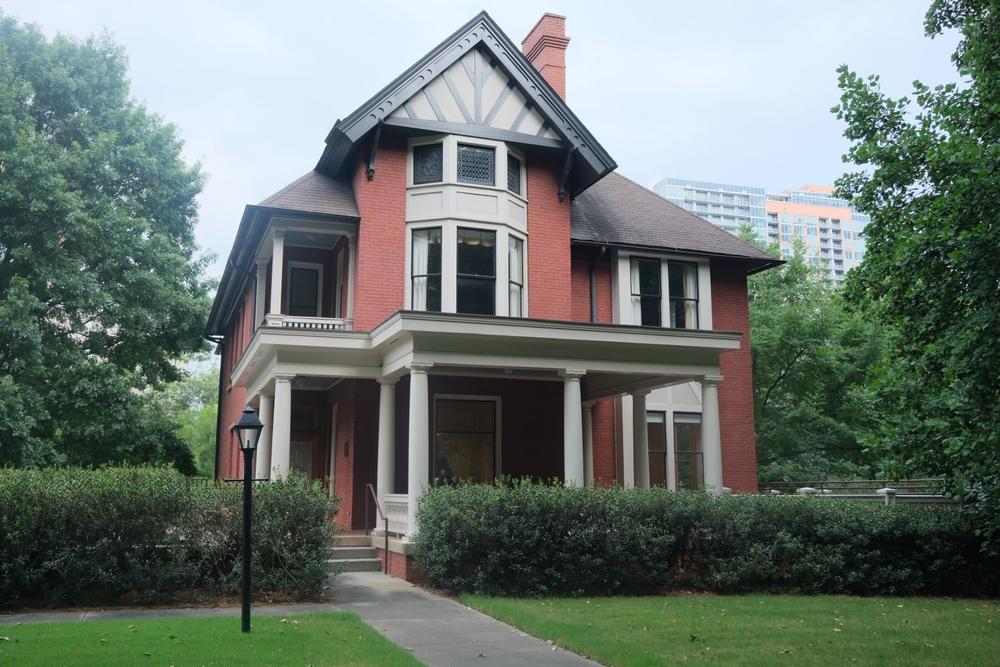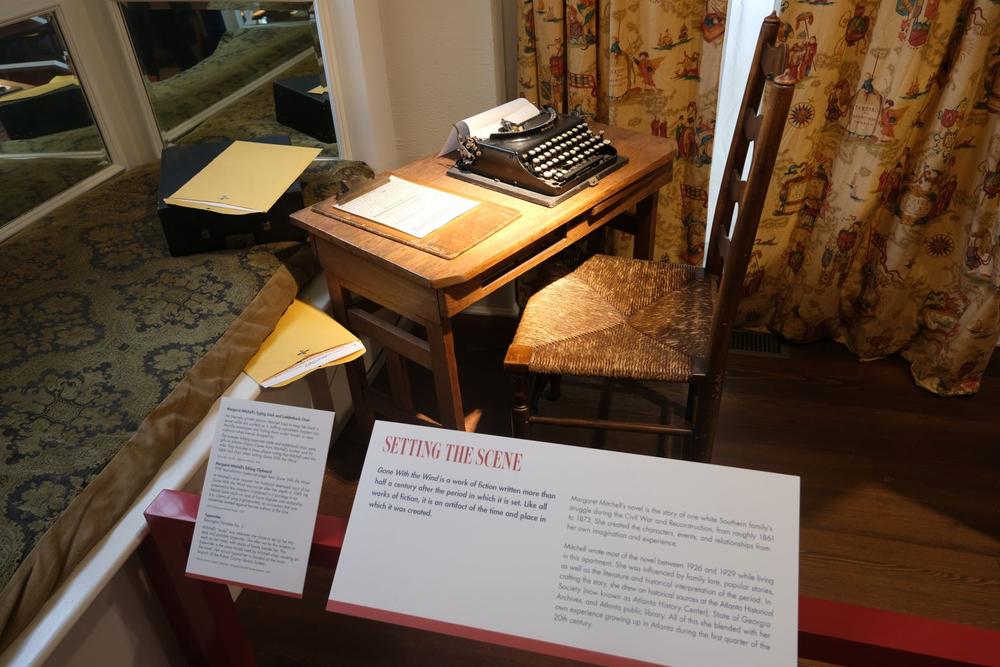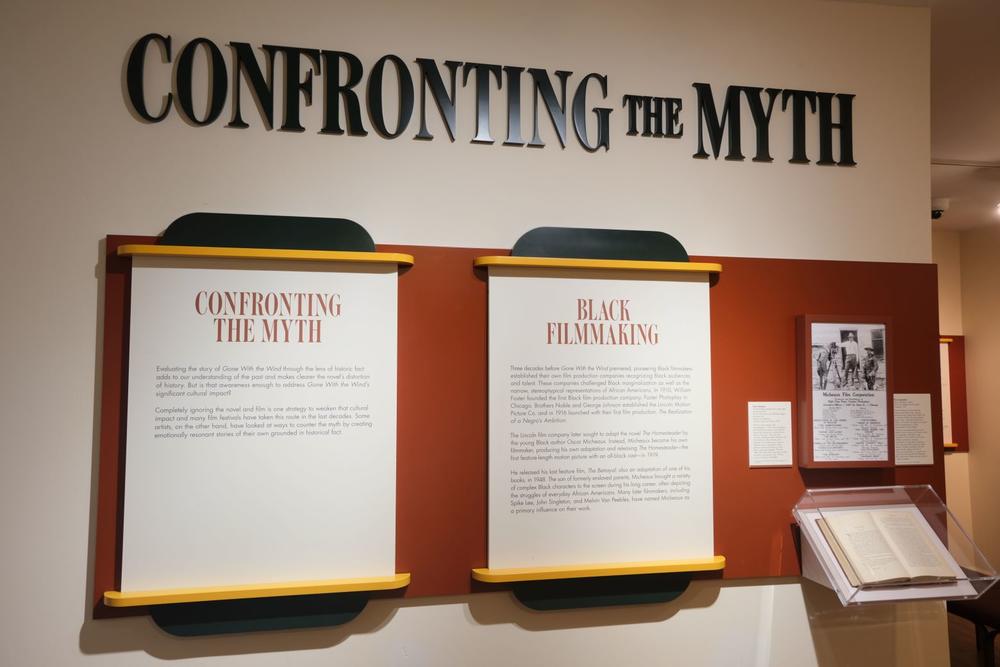
Caption
The Margaret Mitchell House sits at the corner of 10th and Peachtree Streets in Midtown Atlanta. The house was set to reopen after a four-year closure on July 10, 2024.
Credit: Allexa Ceballos / GPB News
|Updated: October 6, 2024 1:49 PM
LISTEN: The Margaret Mitchell House was closed in March 2020 because of the pandemic but remained closed for four years to undergo a complete transformation. It's now reopening. GPB's Orlando Montoya has more.

The Margaret Mitchell House sits at the corner of 10th and Peachtree Streets in Midtown Atlanta. The house was set to reopen after a four-year closure on July 10, 2024.
The house museum where Atlanta writer Margaret Mitchell wrote Gone with the Wind has seen an increase in visitors since reopening this summer.
The building was closed from March 2020 until July 2024. But it's not the same as it was.
The building sits on a busy corner that the writer hardly could have imagined when she lived there nearly a century ago. High-rises and commercial bustle surround the three-story house with its large front yard and a porch.
But the real change is inside the museum itself, as it addresses some of the myths undergirding the classic novel — especially the book's views on slavery, the Civil War and Reconstruction.
The house closed in March 2020 when tourism ground to a halt because of the COVID-19 pandemic.
Prior to the closure, about 40% of the museum’s visitors were from other countries.
“That’s a key part of our business strategy,” said Sheffield Hale, CEO of the Atlanta History Center, which owns the house. “And so, I think that they’re back and so we’re open. And we’re very excited about that.”
The closure turned out to be an opportunity for the Atlanta History Center to completely reimagine what they do with the space.

The desk that Margaret Mitchell wrote on and a typewriter that wasn't hers — but comes from the same period of time — are two of the first things that visitors see after entering the Margaret Mitchell House in Atlanta.
“The exhibits that were in the house had been up for many years at that point,” said Clare Haley, the Atlanta History Center’s vice president of special projects. “We wanted to give folks a new experience so they had a reason to come back and maybe learn something new and see something different.”
The house museum now addresses head-on how the story might not have appealed to many Americans, especially when it premiered as a movie, produced by David O. Selznick, in a segregated Atlanta in 1939.

New exhibits at the Margaret Mitchell House address the myths about slavery and Reconstruction that undergird her epic story "Gone with the Wind."
“There are some correspondence that we have between David O. Selznick and Walter White, who was the head of the NAACP at that time," Haley said. "And Walter White writes to Selznick and tells him, ‘Look, within Gone with the Wind, there are some problems with the way Black people are portrayed. It’s not reflective of the history of slavery and Reconstruction and perhaps you can look at ways that you can mitigate some of that in the film.”
Selznick made some small changes.
The new exhibit goes further.
By elevating some of the real history of Reconstruction, the exhibit debunks some of the myths undergirding Gone with the Wind.
There’s also another book featured prominently — that of another Atlanta writer, W.E.B. Du Bois, whose Reconstruction in America was published just a year before Mitchell’s epic and challenged the prevailing historical narrative of the same period covered in Gone with the Wind.
So there’s a lot to chew on.
After four years, artifacts that you’d expect to be here still remain — including period furniture and the original desk that Mitchell wrote on.
On display for the first time is the actual suitcase that took the pages of her still-unpublished novel to a New York publishing firm.
But there also are exhibits such as glass cases filled with about a dozen books showing how Gone with the Wind got interpreted into many languages — including some those international visitors might have read it in.
“Especially after World War II, its popularity really picked up internationally, I think for similar reasons to why it was originally popular in the U.S. on the heels of the Great Depression,” Haley said. “There were a lot of people who had been through incredibly rough times. Here in Gone with the Wind, you have a story of a woman surviving a devastating war and coming out on the other side with resilience and pluck and courage. And I think that really appealed to those who found themselves on the other side of war.”
“I think it’s just so important to keep this going,” said Sheffield Hale. “There’s something about being in the birthplace of Gone with the Wind that makes all kinds of discussions richer.”
Since reopening, museum staff members say visitors have been engaged in the new perspective.
The museum also has started reinvigorating the ongoing programming there, including author talks, special panels and events.
The newly renovated Margaret Mitchell House is open 9 a.m. to 4 p.m. Tuesday through Sunday.